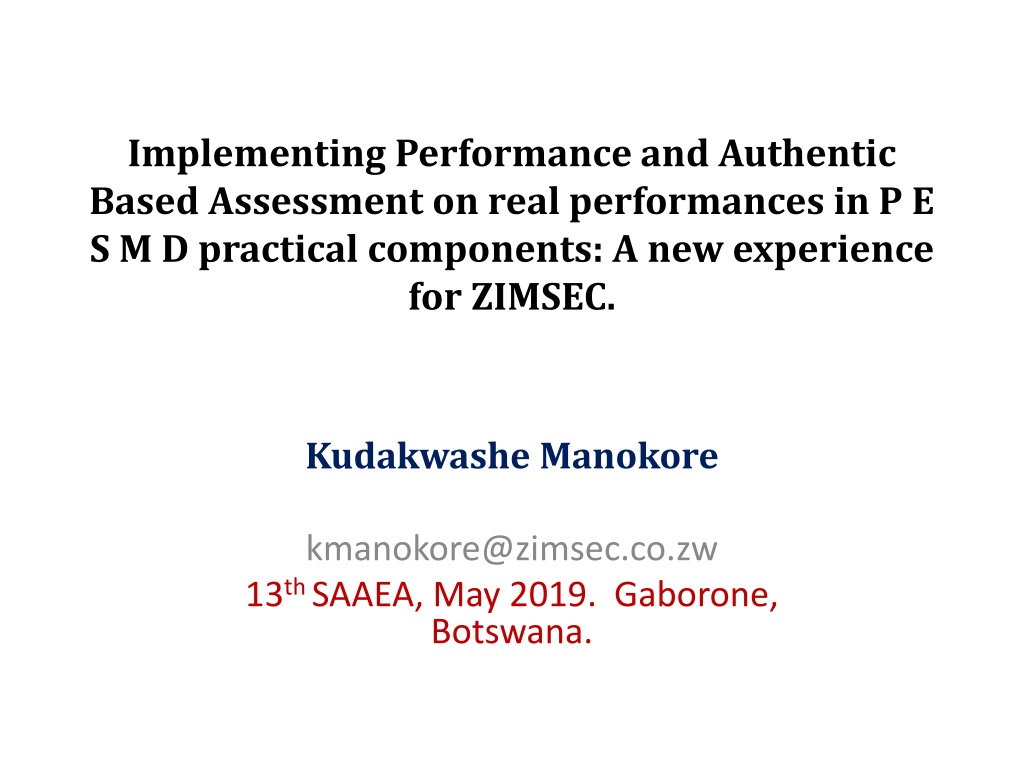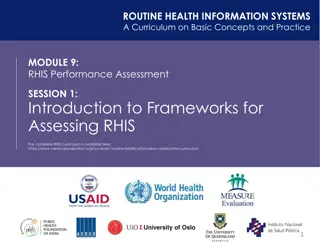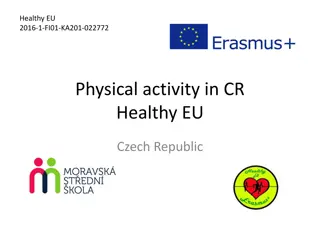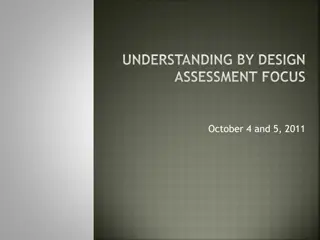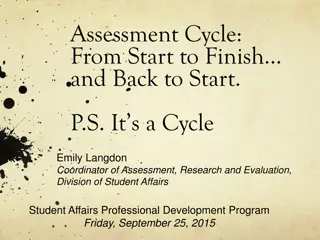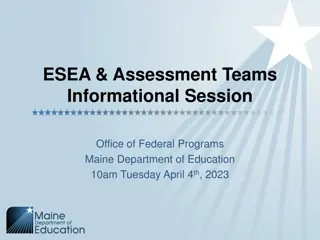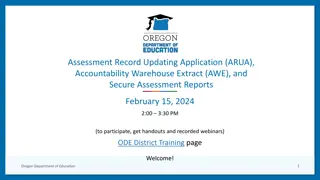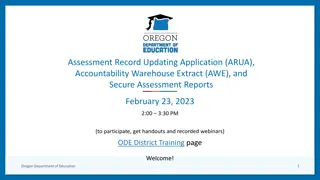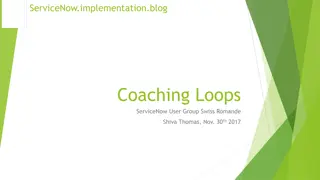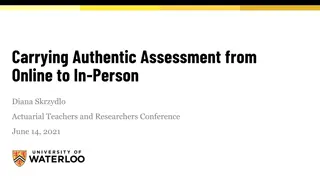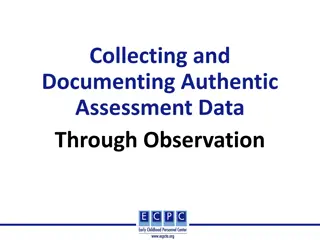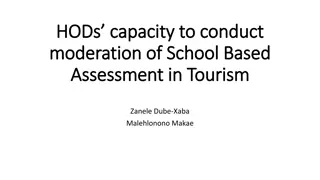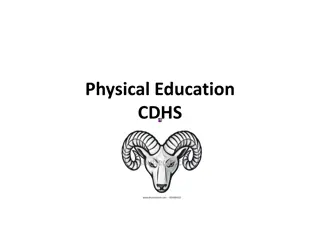Enhancing Assessment in Physical Education through Performance-Based Methods
Zimbabwe's ZIMSEC explores the feasibility of Performance and Authentic-Based assessments for the Physical Education, Sport, and Mass Displays (PESMD) practical components. The study aims to enhance the accuracy of assessing candidates based on real performances, aligning with the Competence-Based Curriculum Framework. By training examiners and implementing standardized assessment methods, the study intends to address common challenges in PESMD practical assessments and improve overall examination procedures.
Download Presentation

Please find below an Image/Link to download the presentation.
The content on the website is provided AS IS for your information and personal use only. It may not be sold, licensed, or shared on other websites without obtaining consent from the author. Download presentation by click this link. If you encounter any issues during the download, it is possible that the publisher has removed the file from their server.
E N D
Presentation Transcript
Implementing Performance and Authentic Based Assessment on real performances in P E S M D practical components: A new experience for ZIMSEC. Kudakwashe Manokore kmanokore@zimsec.co.zw 13th SAAEA, May 2019. Gaborone, Botswana.
Introduction and Background Zimbabwe adopted a New Curriculum Framework 2015-2022; (Competence Based ) Physical Education Sport and Mass Displays (PESMD);examinable learning area in 2017. Selection and recruitment of examiners. The Provincial Based Assessment Model (PBAM).
Statement of the study The assessment criteria for PESMD practical component is inform of coaching points. Candidates perform specific skills that are to be assessed. e.g. passing a ball in a given context. ZIMSEC adopted Performance and Authentic Based Methods of assessment. ZIMSEC pre-tested the methods during Training of examiners, Coordination and Standardisation.
Objectives Determine the feasibility of Performance and Authentic Based Assessment on actual PESMD performances. Train PESMD examiners to assess candidates from observation. Grade PESMD examiners according to their assessment ability.
Research questions Where is the connection between coaching points-PBA and ABA? How prepared were examination centres in the study to offer conducive conditions for PESMD practical assessment? Which assessment challenges are most common in PESMD practical assessment?
Significance of the study To the council: Test performance and authentic based assessments. Recruit and grade the examiner trainees according to their ability to assess the practical components using the agreed standard procedures and grades.
Theoretical framework Assessment principles: Performance and Authentic -Based Assessment (Competence Based and Outcome Based) PBA Hilliard (2015) -measures learners' ability to apply the skills and knowledge learned from a unit or units of study. Griffith & Lim (2012)-performance of tasks that are meaningful and engaging to learners. Most genuine assessments require learners to complete a task that closely mirror the responsibilities of a professional. ABA O Malley and Pierce (2011) - examine learner s collective abilities. Wiggins (1990)-three factors : the task, the context, and the evaluation criteria. "Fairness -exists when assessment is appropriate. When it is personalized, natural, and flexible, when it can be modified to pinpoint specific abilities and function at the relevant level of difficulty. Ensures curricular validity, and minimises evaluator bias. However, its time-intensive.
Literature Review Wiggins (1990)-Realism . Prior knowledge, time to complete the activity, and opportunity to reflect or consult appropriate resources. Meyer (1992)-performance assessment refers to the kind of student response to be examined, while authentic assessment refers to the context in which that response is performed. Assessment Rubric Griffith & Lim (2012) - a device or instrument to measure the skill ( a rubric). A rubric includes the specification of the skill being examined and what constitutes various levels of performance success. Focusing on exactly what to measure, how to measure performance, and may be fine-tuned to meet the specific requirements of any given task activity. Meyer (1992)-the authenticity of assessment lies in the stimuli, task, complexity, locus of control, motivation, spontaneity, resources, conditions, criteria, standards, consequences among other facets.
Assessment Model Advance information To allow for PBA and ABA. To guide examination centres on their preparations for the assessment. To guide the candidates on question choices . Phases National Training of examiners National Coordination and Standardisation Provincial Coordination and Standardisation Provincial Based Assessment Model (PBAM) ZIMSEC supervises all processes.
Methodology A mixed approach. Documents (supervision tools)-moderate and standardise work by examiners. Mark Deviation form on trainee examiners. Assessment of Markers form- grade examiners. Participant observations - assessments 3 phases-Examiner Training (120 trainees) National Coordination (22 examiners) and Actual Assessment (6 examiners, assessing 254 candidates).
Training and Coordination Examiner Grade Mark Deviation Description Number of Examiners A 0 2.0 Leader Material Independent Marker Supervision needed Unsuitable 20 B 2.1 3.0 51 C 3.1 4.5 47 D 4.6+ 2 TOTAL 120 While the mark deviations in grade C are acceptable, the examiners marking was affected by other factors such as subjectivity, halo effect, position of the assessor, concentration just to mention these.
Training and Coordination (cont.) The understanding of some skills depended on how the examiners themselves were taught; it was difficult to arrive at a universal body posture .e.g. proper sit ups , reasonable distance Examiners agreed to modify sit ups, distances for girls, the action may prejudice some candidates and favour others. Pair or group work posed some challenges, as one candidate s performance could directly affect others. e.g. Mass Displays and game situations. Adjustment of professional standards for assessment purposes. Conflict between sport rules and assessment standards for candidates. e.g. FIBA or FIVB rules. Questions with scenarios raised debate on where the candidate should exactly start the demonstration. Allocation of marks on time management and attire. Safety issues.
Assessment of Real Performance Some candidates missed sequences they had planned for but still demonstrated the correct skills as expected. Candidates who were waiting for their turn to be assessed, cheered or shouted, some tried to solicit for information. Demonstrations and activities running concurrently. It was not easy for the examiners to record some quick events like (correct hop, step and jump) all at once but in stages, unit by unit. Adjustments on the standards also affected negatively some candidates who were already talented in a particular sport code. Some candidates changed partners during assessment. Some special needs candidates were identified by examiners during assessment.
Assessment of Real Performance (cont..) There were some delays between intervals as candidates used the same equipment and space or decided on options while the examiner waited to assess. One PESMD teacher interfered with an examiner, on the assessment of the football question. Some candidates were assessed in the afternoon when the weather conditions were no longer favourable as compared to their counterparts who were assessed in the morning. The position of the examiner is important in assessment as some views maybe obscured by the candidates themselves. A number of candidates from one centre demonstrated exactly the same skills on a question. On the soccer question, one feeder started coaching the candidate being assessed; however, the examiner picked it and reprimanded the pair.
Discussion of Findings The majority of examiners passed the training and coordination exercise as either, leaders or independent examiners, this confirmed that it is possible to assess real performances that are Performance and Authentic based. Some examiners failed the training or were graded as needing supervision. This is evidence that, there are challenges to using authentic assessment methods. Need to adjust or modify some standards for assessment purposes. However, the connection with the real-world situations should be maintained & examinations should be able to offer these conditions. While learners are asked to perform a specific behaviour to be assessed, one big challenge with contrived contexts is that candidates may imitate each other in demonstrating skills. Assessors themselves were not too familiar with certain areas that they were supposed to assess. This may be a challenge as PESMD teachers and examiners should be able to identify the purpose of assessment in order to determine whether performance or authentic assessment is relevant (Meyer, 1992). There is need for assessment language and vocabulary to be taught to PESMD examiners and teachers.
Conclusions Some centres did not get adequate advance information and time to prepare. This was against the principles of PBA and ABA. Candidates should perform without spectators. The invigilator should signal candidates for assessment in a given order. All standards on questions should be determined during coordination and standardisation exercise so that no room is left for guess work during marking. Examiners should allow candidates to change partners as they wish as long as they are within their assessment time. There is a tendency of pairs coaching each other during assessment; hence examiners should be on guard for pair and group activities. Candidates should be allowed to use what they are familiar and comfortable with during assessment so as to increase the authentic of the assessment.
Recommendations During coordination, demonstrations should be part and parcel of the standardisation exercise so as to capture all possible related skills. A need for examiners to playback professionalvideo clips for reference. Disciplines that are taught in groups and require candidates to work together should be assessed as such. (Environments to be as natural as possible to resemble the real world). Examination questions should address game rules instead of sporting rules as the prior can be adjusted to the required standards. Comparable and informed standards should be used for assessment. Examiners should watch out for the halo effect. Centres should record candidates performance and submit soft copies to ZIMSEC for assessment. National, Provincial Coordination and Standardization exercise should be done well in time to allow earlier detection of potential assessment challenges. Minimal marks should be allocated to the sequences, time management and attire while the bulk of the scores are given to skill mastery. Safety should be emphasized and prioritized during assessment. Centres should notify ZIMSEC on all special needs cases. Examiners should position themselves strategically for assessment.
